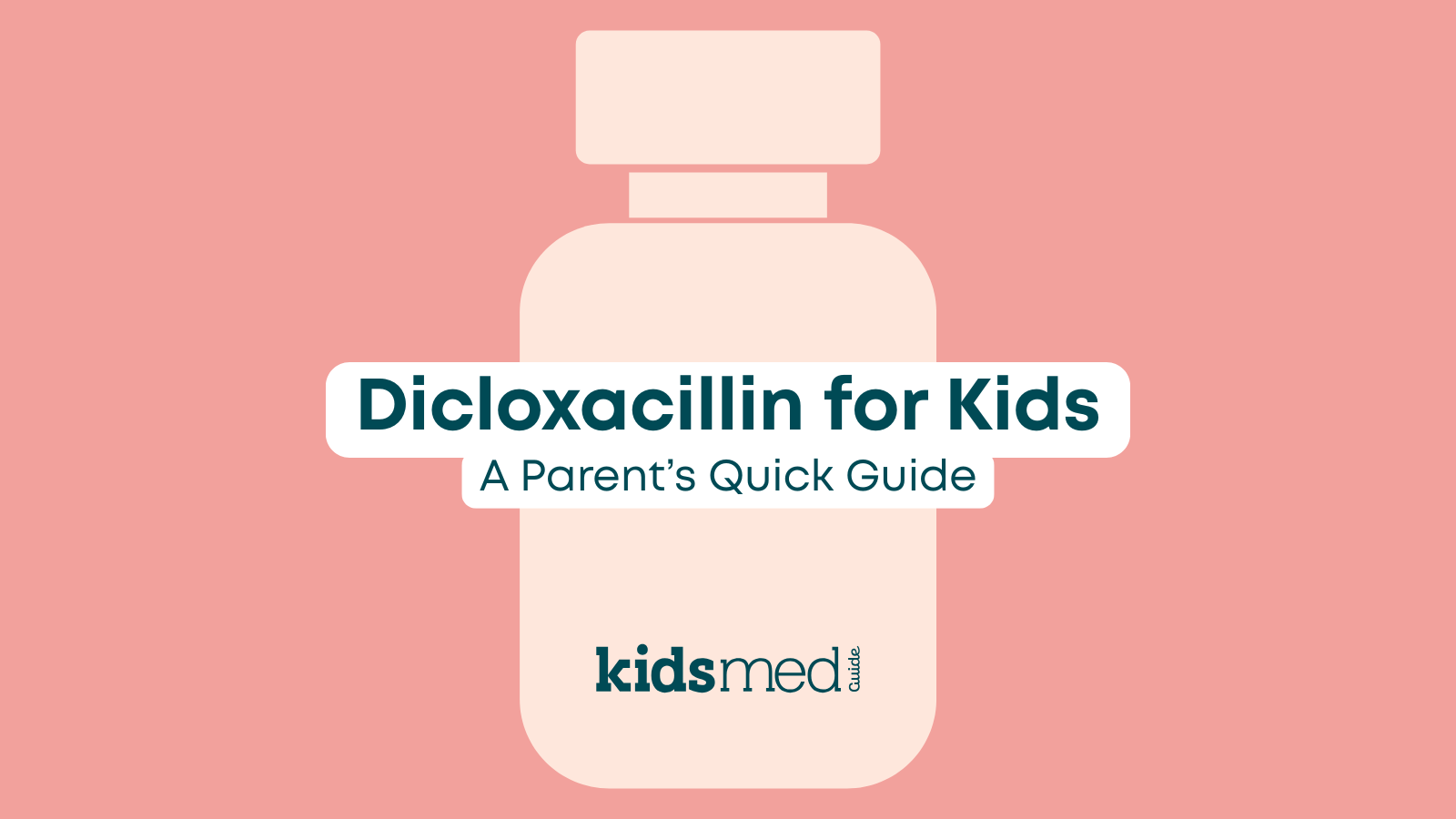Med Minute: Dicloxacillin

Dicloxacillin is another type of antibiotic in the penicillin class (we’ve discussed several!). The most common use in children is to treat skin infections; if your child has a suspected staphylococcal skin infection, such as impetigo, a boil, or cellulitis, your pediatrician might prescribe dicloxacillin. It’s a penicillinase-resistant penicillin, meaning it targets specific strains of staph bacteria that are resistant to penicillin.
What’s It Commonly Used For?
Dicloxacillin for kids is used when the infection is caused by penicillinase-producing Staphylococcus aureus that is susceptible to this medicine. These germs are common causes of skin and soft-tissue infections such as boils, impetigo, and cellulitis. Cultures and sensitivity tests help confirm the choice of antibiotic is correct.
If you’re curious why your pediatrician chose this medicine instead of another antibiotic, read: Why Your Pediatrician Chose This Medication—and Not Another.
How Does It Work?
Dicloxacillin belongs to the penicillin family. Like other penicillins, it interferes with bacterial cell wall synthesis, leading to bacterial death. Important to remember: antibiotics treat bacterial, not viral, infections.
What’s the Dose?
The dicloxacillin dose for children is based on weight. According to the package insert, the usual pediatric dose for children weighing less than 40 kg (88 lb) is 12.5 to 25 mg per kilogram of body weight per day, divided into equal doses every 6 hours. Children weighing more than 40 kg receive the adult dose of 125 to 250 mg every 6 hours.
Your pediatrician will determine the precise dose and frequency appropriate for your child based on the severity of the infection and your child’s weight. Treatment duration depends on the severity of the infection. For severe staph infections, therapy usually lasts at least 10-14 days and continues for at least 48 hours after your child’s fever and symptoms improve.
Even if your child feels better fast, completing the full course helps prevent the infection from returning and reduces the chances of bacteria developing resistance. For more information about understanding prescription instructions, see How to Read Pediatric Medication Labels.

What Are the Most Common Side Effects?
Most children tolerate dicloxacillin well, but some side effects can happen. The most common include mild nausea, vomiting, diarrhea, or rash. One rare but unusual side effect? Some kids might also notice a temporary change in taste or a rare but memorable side effect — a black or “hairy” tongue. (Don’t worry, it’s harmless and goes away after stopping the medication. Sadly, it doesn’t make your child look like a baby dragon.)
Severe allergic reactions are rare but can occur—especially in kids with a known penicillin allergy. Watch for hives, swelling, or trouble breathing, and seek emergency care if these happen.
Serious GI effects, including C. diff infections, can also occur. If your child has any gastrointestinal conditions, this medication should be used cautiously. It should also be used cautiously in newborns and young infants and should not be given to children taking certain medications, including tetracycline.
How Should My Child Take It?
Food can reduce the absorption of dicloxacillin. Unless your healthcare provider advises otherwise, give it on an empty stomach — about 1 hour before or 2 hours after meals. Administer it with at least 4 ounces (120 mL) of water, and avoid giving it right before bedtime or while your child is lying down to lower the risk of esophageal irritation. Space doses evenly and complete the entire course.
Key Safety Notes
- Allergy warning: Do not use if your child has a known penicillin allergy; hypersensitivity can be severe.
- Use only as prescribed for a bacterial infection. Antibiotics do not treat colds or flu.
- Drug interactions: Avoid tetracyclines with penicillins, as they can decrease effectiveness. Probenecid can increase dicloxacillin levels. Monitor if used with warfarin or other anticoagulants. Always consult your pharmacist or pediatrician before adding any medicines, including over-the-counter drugs.
- Caution should be used in certain patients, including newborns and young babies, and children with a history of a GI disorder. Talk to your child’s pediatrician.
Related: Amoxicillin: A Guide for Parents and Caregivers
Conclusion
Dicloxacillin is an antibiotic effective against certain skin infections caused by stubborn Staph bacteria. It does not work against MRSA. When taken as prescribed, it is safe, effective, and—aside from occasional side effects like dragon-tongue—generally well tolerated. Just remember to finish the whole course, take it on an empty stomach with water, and inform your pediatrician about any side effects.
Frequently Asked Questions
How quickly does dicloxacillin start working?
Response varies. Your pediatrician will check your child’s progress and let you know what to expect. Continue the medicine exactly as directed, even if your child feels better early. Depending on the infection, some patients will feel better within 48 hours.
Can dicloxacillin be taken with other medicines?
Some medicines interact, including tetracyclines, probenecid, and warfarin-type anticoagulants. Ask your pharmacist or clinician before adding anything new, including OTCs.
What should I do if my child misses a dose?
Follow your prescriber’s guidance. Do not give extra doses without checking first.
How long does my child need to take dicloxacillin?
It depends on the infection and response. Some severe staph infections need at least 10-14 days, and therapy generally continues 48 hours after fever and symptoms resolve. Your pediatrician will advise the exact duration.
When should I seek medical help while using dicloxacillin?
If symptoms worsen or your child develops signs of allergic reaction or severe diarrhea (possible pseudomembranous colitis), contact your clinician or seek emergency care right away.
The following references were used to compile this information:
DailyMed—DICLOXACILLIN SODIUM capsule. (n.d.). Retrieved October 23, 2025, from https://www.dailymed.nlm.nih.gov/dailymed/drugInfo.cfm?setid=9074b5a6-850c-4144-9097-bb21073ee54d&audience=consumer



